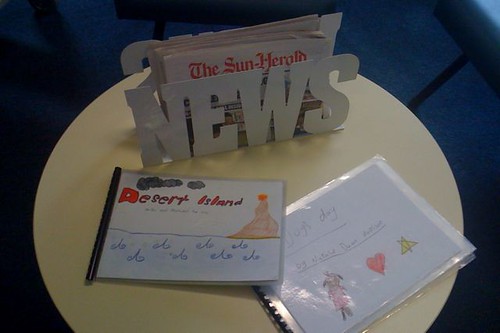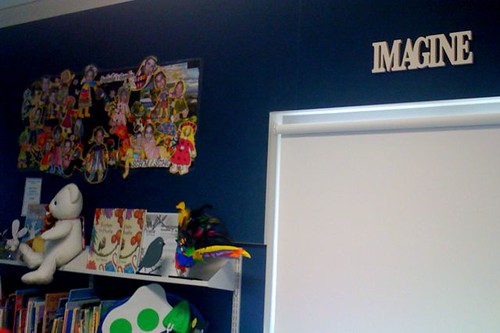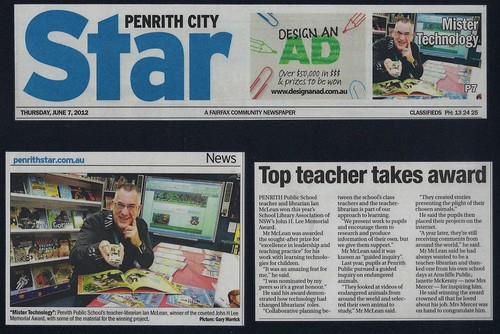Pic by Gary Warrick. Penrith City Star‘s coverage of my John H Lee Memorial Award for “excellence in leadership in innovative and collaborative teaching practice through the integration of learning technologies”. Presented jointly by School Library Association of NSW and Charles Sturt University. See the full article HERE.
Tag Archives: newspapers
Good news week?
A quick blog entry to share two new purchases:

This metal newspaper rack was picked up in a St Clair bargain ship for $19.99. At the moment, it’s holding some copies of last year’s Premier’s Reading Challenge honour roll inserts.

This “Imagine” sign was already painted white. Not a bad find at $9.99, also at St Clair.
We actually spent today – between teaching – attempting to consolidate two poster racks, jammed full of posters, into one. A job we never attended to, even when we had the racks in storage while the new BER library was being built. Lots of the posters are terribly dated, especially the ones from the late 60s. A few we are keeping for pure nostalgia value.
When the rectangular-frame rack is empty, I plan to turn it into a puppet theatre. The other rack, which has crossbars, should hold what’s left of the posters, but I still think it’s an efficient storage method. The posters have had call numbers for many years, but were never accessioned. We hope to add a brief record for each to OASIS. It’s been frustrating that no posters appear in a subject hearing search. We aren’t going to go too overboard, though, because once every classroom has an IWB, posters in classrooms may well become obsolete.
I shall keep you posted on some other, upcoming “good news”…
Rap reports
The Stage 2 students and I had a great time this week writing up their sports reports for the Beijing Olympics & Book Week 2008. They came to the library with their class teacher (who is brand new to rapping) – usually we’ve had two rotating groups instead, but with the industrial action of yesterday morning, there were lots of students still absent in the afternoon.
We went through the key elements of a newspaper sports report/article, using the supplied Rap Sheet, then read and analysed the “Kiwis vs Wallabies” report from The Shaggy Gully Times by Jackie French & Bruce Whatley. When it came time to break into writing groups, the students were highly motivated, and they were so empowered whenever they made up a clever pun. Of course, it really helped that one of the students was fresh off the plane from her recent visit to Beijing – and that the extremely fast gold-medal winning Jamaican athlete she told us about had the highly punny surname of Bolt!
By the way, it only occurred to us later why that Shaggy Gully football match was being played at night!
Yes, it’s been a a busy term, but traditionally Term Three always is in school libraries: Book Week, National Literacy & Numeracy Week, and all that.
Rap Point 2 stretched across two weeks this time, on purpose, and it was also okay to post a bit late, since each school in the rap tends to work at a different pace. There had been a few new schools only just starting to look around the pages and/or noticing the newer messages on earlier rap points.
I decided to concentrate on prediction that week. I like to get the students to anticipate what might be coming next, so we predicted how we would:
* find the rap blog, with which search terms (eg. on Google)
* recognise our post from last week (ie. look out for school crest avatar).
Also, we predicted the contents of the page of The Shaggy Gully Times we’d be reading in the rap session. I asked one group of students to make predictions as to what they’d see inside the local newspaper when I unrolled it (fresh from my front lawn). Local newspapers are a great free resource, and many times they only get noticed by the students when they are asked to clean out the budgies’ cage, or collect newspapers for covering school desks during art, or when making papier mache.
The students were very engaged in skimming the layout, quickly identifying and confirming almost all their predictions about the newspaper. The standard of talking and listening was very pleasing – they were perceptive, and supportive of each other’s earlier ideas.
I hope this is an activity they will be able to repeat with their parents. (And that the newspaper they choose doesn’t have too many full page ads for local attractions such as “Wild Boys Afloat”, etc.) Several students reported recently that they’d personally gone online and shown their parents the current rap blog on their home Internet computers. One girl said, “I even printed out the page that had my name and comment on it.”
Newspaper clipping generator: Extra! Extra!
Last term, I worked with Stage 3 students (four Year 5 & 6 classes) on a WebQuest about bushrangers, to complement the work they were doing in class: the Human Society & Its Environment unit, “Gold!”
I started by asking their teachers which elements of the unit, in past years, had been the most difficult to cover in class. Since a lot of home class time was devoted to an engrossing simulation game, the part they felt was suddenly sprung upon the students was the imminent arrival of a “bushranger” (secretly invited teacher or executive staff member), who “robs” the students (who until that point are often reluctant to “bank”). Depending on the whim of the “guest bushranger”, many of the students end up losing a lot of “money”, “gold” and (sometimes) even their gold-seeking equipment in the game.
I ended up creating my own “guided enquiry” WebQuest because existing ones on the Internet encouraged the students to assume the role of a bushranger. (Is it a good idea to have students play lawbreakers / robbers / murderers?) When I came across a fascinating little website called Newspaper clipping generator, I realised that a more positive angle was to have the students be newspaper journalists for a goldrush-era colonial newspaper.
After the preliminary activities, the students worked in small groups to complete a facts matrix using Internet and book resources. During their weekly library sessions, we also focused on the limited photographic and printing technologies and facilities of colonial times, and the need for text-based physical descriptions of their selected bushranger(s).
The presentation format was not announced until all research was completed. Explicit teaching, at point of need, also included deconstruction of effective newspaper headlines and colonial-era “Wanted” posters, discussion of how to select a suitable date for an article, and a focus on colonial newspaper journalistic styles and language (including terms which are not “politically correct” in 2008).
The students’ newspaper clippings about their chosen “notorious” bushrangers are at:
http://goldquest.edublogs.org/pps-bushranger-bounties/
 Pre- and post-tests were done to establish how well these WebQuest activities improved the students’ learning. Just watching the confidence of the students as they completed their post-tests told me that the unit of work had been very successful. I shall report further on my findings soon.
Pre- and post-tests were done to establish how well these WebQuest activities improved the students’ learning. Just watching the confidence of the students as they completed their post-tests told me that the unit of work had been very successful. I shall report further on my findings soon.
Afterthoughts: Ruth Buchanan did a great post over at Skerricks about books versus virtual resources in student research. I mentioned in my comment to her post that our “Gold!” research saw a similar phenomenon to hers, but with our Stage 3 students. With very limited time to complete the task over several weeks, I’d set up lots of “bushrangers research” Internet links from a central online locale, and showed the students which links I thought might be more useful, but many happily scampered off to see what “real books” we also had on the topic.
The biggest problem we found was one link off a WebQuest page: the link was to previous student research from another school (and from several years ago), and the accuracy of that information varied from student to student, even though their final products closely resembled webpages uploaded by so-called “professional” Australian historians.
Similarly, the work we‘ve now uploaded (to the Gold Quest blog we shared with Caddies Creek PS) – to give all the students the chance to share their findings online – is not necessarily 100% accurate.
The whole exercise has also reminded me how much work is involved for an editor to check historical facts in books and websites. I can’t possibly go through every student author’s sources and confirm every detail. To a certain extent, a “chief editor” and publisher must trust an author’s research strategies (and literary licence to express facts in valid ways).

